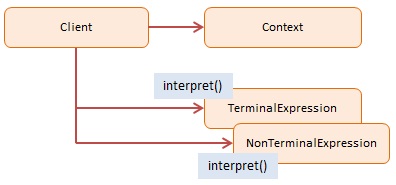Given a language, define a representation for its grammar along with an interpreter that uses the representation to interpret sentences in the language.
| Usage in JavaScript: |
|
low |
The Interpreter pattern offers a scripting language that allows end-users to customize their solution.
Some applications are so complex that they require advanced configuration. You could offer a basic scripting language which allows the end-user to manipulate your application through simple instructions. The Interpreter pattern solves this particular problem – that of creating a simple scripting language.
Certain types of problems lend themselves to be characterized by a language. This language describes the problem domain which should be well-understood and well-defined. To implement this you need to map the language to a grammar. Grammars are usually hierarchical tree-like structures that step through multiple levels and then end up with terminal nodes (also called literals).
Problems like this, expressed as a grammar, can be implemented using the Interpreter design pattern.
Today, if you really need this type of control in JavaScript it is probably easier to use a code generator like ANTLR which will allow you to build your own command interpreters based on a grammar that you provide.

The objective of this example is to build an interpreter which translates roman numerals to decimal numbers: for example, XXXVI = 36.
The Context object maintains the input (the roman numeral) and the resulting output as it is being parsed and interpreted. The Expression object represents the nodes in the grammar tree; it supports the interpret method.
When running the program, a simple grammar tree is being built which then processes a roman numeral and translates it into a numeric.
var Context = function (input) {
this.input = input;
this.output = 0;
}
Context.prototype = {
startsWith : function (str) {
return this.input.substr(0, str.length) === str;
}
}
var Expression = function (name, one, four, five, nine, multiplier) {
this.name = name;
this.one = one;
this.four = four;
this.five = five;
this.nine = nine;
this.multiplier = multiplier;
}
Expression.prototype = {
interpret: function (context) {
if (context.input.length == 0) {
return;
}
else if (context.startsWith(this.nine)) {
context.output += (9 * this.multiplier);
context.input = context.input.substr(2);
}
else if (context.startsWith(this.four)) {
context.output += (4 * this.multiplier);
context.input = context.input.substr(2);
}
else if (context.startsWith(this.five)) {
context.output += (5 * this.multiplier);
context.input = context.input.substr(1);
}
while (context.startsWith(this.one)) {
context.output += (1 * this.multiplier);
context.input = context.input.substr(1);
}
}
}
function run() {
var roman = "MCMXXVIII"
var context = new Context(roman);
var tree = [];
tree.push(new Expression("thousand", "M", " " , " ", " " , 1000));
tree.push(new Expression("hundred", "C", "CD", "D", "CM", 100));
tree.push(new Expression("ten", "X", "XL", "L", "XC", 10));
tree.push(new Expression("one", "I", "IV", "V", "IX", 1));
for (var i = 0, len = tree.length; i < len; i++) {
tree[i].interpret(context);
}
alert(roman + " = " + context.output);
}
Run
The Namespace pattern is applied to keep the code out of the global namespace. Our namespace is named Patterns.Classic. A Revealing Module named Interpreter returns (i.e. reveals) only a single item: the evaluate method. All other items are kept private in the module: OO encapsulation at its best.
The Patterns object contains the namespace function which constructs namespaces non-destructively, that is, if a name already exists it won't overwrite it.
The log function is a helper which collects and displays results.
var Patterns = {
namespace: function (name) {
var parts = name.split(".");
var ns = this;
for (var i = 0, len = parts.length; i < len; i++) {
ns[parts[i]] = ns[parts[i]] || {};
ns = ns[parts[i]];
}
return ns;
}
};
Patterns.namespace("Classic").Interpreter = (function () {
var Context = function (input) {
this.input = input;
this.output = 0;
}
Context.prototype = {
startsWith: function (str) {
return this.input.substr(0, str.length) === str;
}
}
var Expression = function (name, one, four, five, nine, multiplier) {
this.name = name;
this.one = one;
this.four = four;
this.five = five;
this.nine = nine;
this.multiplier = multiplier;
}
Expression.prototype = {
interpret: function (context) {
if (context.input.length == 0) {
return;
}
else if (context.startsWith(this.nine)) {
context.output += (9 * this.multiplier);
context.input = context.input.substr(2);
}
else if (context.startsWith(this.four)) {
context.output += (4 * this.multiplier);
context.input = context.input.substr(2);
}
else if (context.startsWith(this.five)) {
context.output += (5 * this.multiplier);
context.input = context.input.substr(1);
}
while (context.startsWith(this.one)) {
context.output += (1 * this.multiplier);
context.input = context.input.substr(1);
}
}
}
function evaluate(roman) {
var tree = [];
var context = new Context(roman);
tree.push(new Expression("thousand", "M", " ", " ", " ", 1000));
tree.push(new Expression("hundred", "C", "CD", "D", "CM", 100));
tree.push(new Expression("ten", "X", "XL", "L", "XC", 10));
tree.push(new Expression("one", "I", "IV", "V", "IX", 1));
for (var i = 0, len = tree.length; i < len; i++) {
tree[i].interpret(context);
}
return context.output;
}
return {
evaluate: evaluate
};
})();
function run() {
var roman = "MCMXXVIII"
var result = Patterns.Classic.Interpreter.evaluate(roman);
alert(roman + " = " + result);
}
Run